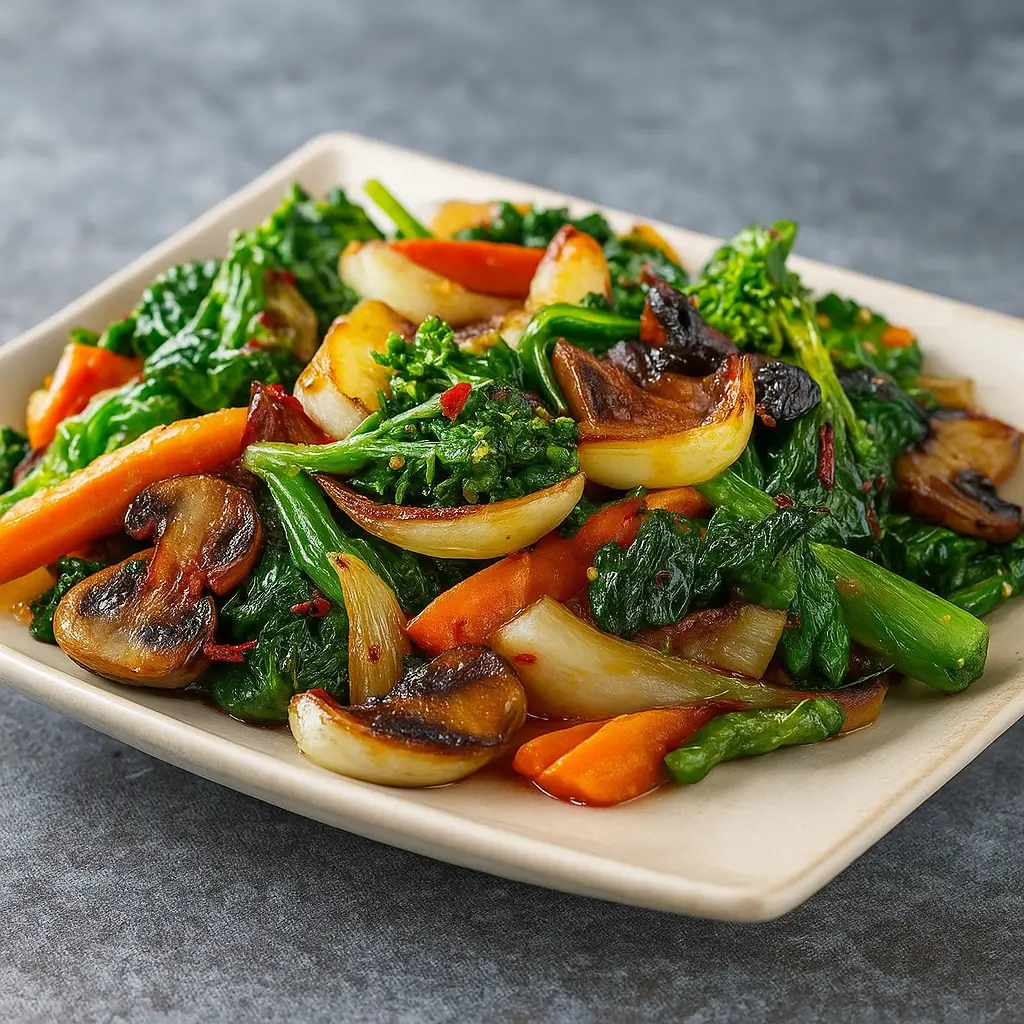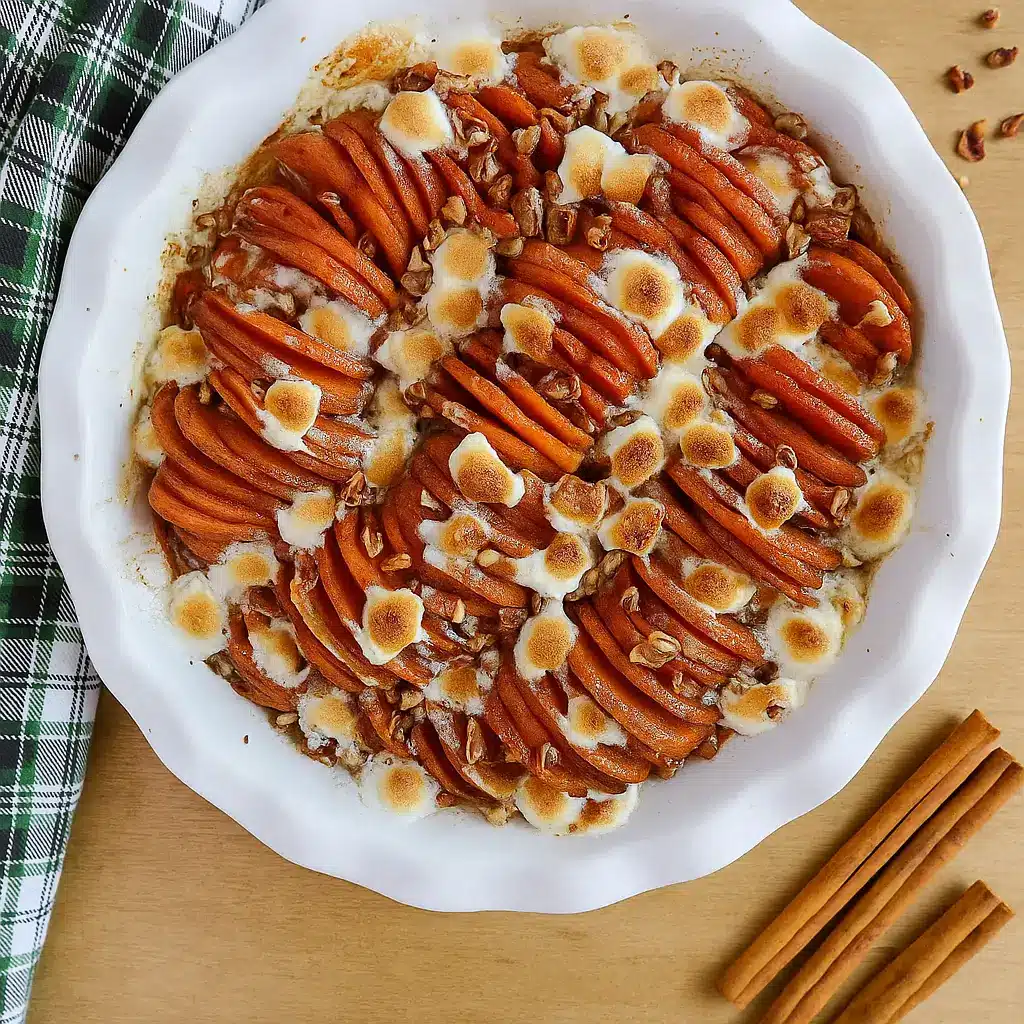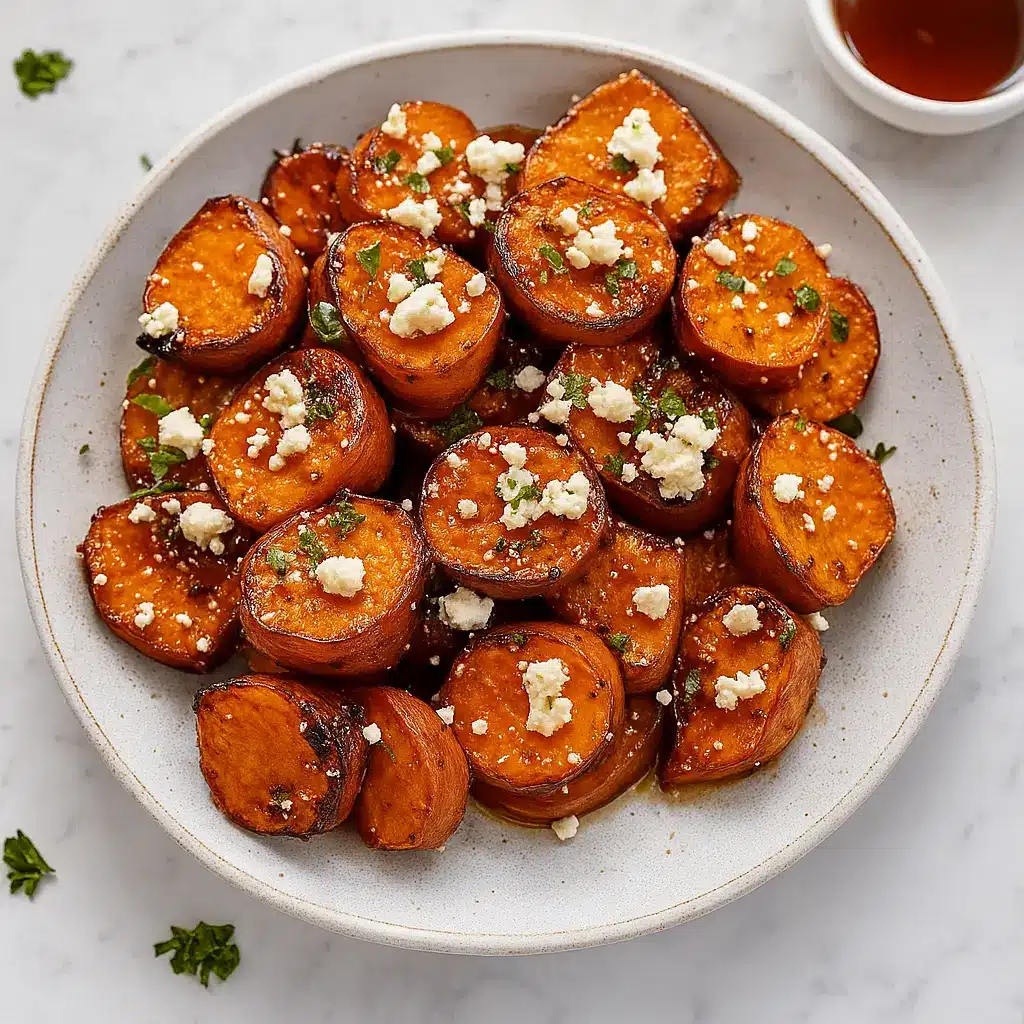Healthy Sautéed Vegetables aren’t just a side dish—they’re the superhero your weeknight dinner needs. Whether you’re dodging picky eaters, racing the clock after work, or just trying to sneak more veggies onto your plate (without hearing a single complaint), this one-pan wonder is your new go-to. It’s fast, fresh, and surprisingly crave-worthy.
Picture this: vibrant veggies glistening with olive oil, kissed with garlic, and just tender enough to still have that irresistible bite. Bonus? You’ll feel pretty great about feeding this to your crew—or just yourself. And if meal prep is your jam, this recipe slides perfectly into your plan. Let’s get into why Healthy Sautéed Vegetables need a permanent spot in your dinner rotation.
Table of Contents
What is Healthy Sautéed Vegetables?
Healthy Sautéed Vegetables is exactly what it sounds like: a mix of colorful, fresh vegetables lightly cooked in a bit of oil until they’re tender but still have some snap. Unlike heavy casseroles or butter-drenched side dishes, this one lets the natural flavors shine.
Think garlic-scented broccoli, sweet bell peppers, and zucchini that isn’t mushy (because we’re not monsters). It’s a simple dish, yes—but don’t let the simplicity fool you. This kind of recipe plays well with nearly any cuisine, from Mediterranean bowls to Asian stir-fries. You can toss it in a grain bowl, pile it next to grilled chicken, or honestly just eat it with a spoon. The beauty of sautéed vegetables is in the technique: a quick, high-heat cook in a good pan that seals in flavor and texture without fuss. No oven required, no deep-frying, just fresh ingredients, a hot skillet, and a little love.
Reasons to Try Healthy Sautéed Vegetables
First off—time. You’ll go from fridge to fork in under 25 minutes, which means it’s ideal for those nights when your energy is dragging but you still want something wholesome. Second, it’s a fridge-cleaner. That lone carrot? Half a bell pepper? This dish embraces all of them. Third, flavor! You’re not just boiling vegetables into sadness. You’re caramelizing onions, bringing out the nuttiness in mushrooms, and building depth with garlic and seasonings.
And let’s not ignore the health perks: fiber, vitamins, antioxidants—this dish is basically your multivitamin in dinner form. Oh, and it’s super flexible. Vegan? It’s got you. Want it buttery and cheesy? Go ahead and top it with Parmesan. Whether you’re feeding toddlers, teens, or yourself at 9:30 p.m. in pajamas, Healthy Sautéed Vegetables is one of those rare recipes that fits into any moment and leaves you feeling like you’ve got it together.
Ingredients Needed to Make Healthy Sautéed Vegetables
- 2 tbsp olive oil (or avocado oil or butter, if preferred)
- 2 cloves garlic, minced
- 1 small onion, thinly sliced
- 1 bell pepper, sliced
- 1 zucchini, sliced into half-moons
- 1 cup broccoli florets
- 1 medium carrot, julienned or thinly sliced
- ½ cup snap peas
- ½ cup mushrooms, sliced
- Salt and black pepper, to taste
- 1 tsp lemon juice (optional, for brightness)
- 1 tsp balsamic vinegar or soy sauce (optional, for depth)
- Optional toppings: toasted nuts, seeds, fresh herbs, or grated Parmesan

Instructions to Make Healthy Sautéed Vegetables (Step-by-Step)
Ready to whip up a vibrant veggie dish without breaking a sweat? Here’s your detailed step-by-step guide to making Healthy Sautéed Vegetables that come out flavorful, crisp-tender, and downright delicious. Follow along with these expanded directions that make cooking feel less like a chore and more like a breeze. Let’s sauté!
Step 1: Gather and Prep All Your Vegetables
The key to a smooth cooking experience? A little prep goes a long way. Start by washing all your veggies thoroughly. Peel where needed (especially those carrots!) and slice them into even pieces. Uniformity matters—it helps everything cook at the same rate. For zucchini, go with half-moons; for carrots, thin julienne slices or rounds work great.
Short on time? Check out our veggie prep hacks to speed things up or learn how to safely use a mandoline for paper-thin cuts. You can even prep everything the night before and store chopped veggies in airtight containers in the fridge—your future self will thank you.
Step 2: Heat Up the Pan Like a Pro
Grab your favorite nonstick or stainless steel skillet and place it over medium-high heat. Let it warm for a minute or two—just enough that when you drizzle in your oil (olive oil is our go-to, but avocado oil works great for higher heat), it spreads easily and shimmers slightly.
This step-by-step warm-up is essential. Starting with a hot pan ensures the veggies sauté instead of steaming, which is the secret to getting that golden, slightly crisp exterior without losing their snap.
Step 3: Sauté Garlic and Onions First for Maximum Flavor
Now comes the flavor foundation. Add your minced garlic and thinly sliced onions to the pan. Stir them around gently with a spatula or wooden spoon for 1–2 minutes. You want them soft and aromatic, not browned or burnt.
Pro tip: If you love bold flavor, consider using a garlic press to release even more of those garlicky oils. Or check out our guide to boosting basic aromatics using pantry staples like shallots or leeks.
Step 4: Add the Harder Veggies First
Time to build some texture. Toss in the broccoli florets and carrot slices—these tougher veggies need a head start. Stir often and sauté them for about 3–4 minutes. You’ll see them start to brighten and soften slightly, but they should still be firm when pierced with a fork.
Here’s a great step-by-step trick: cover the skillet loosely with a lid for 30 seconds at a time to speed up softening without losing the sauté effect.
Step 5: Add the Softer Vegetables Next
Now add the bell peppers, zucchini, snap peas, and mushrooms. These cook much faster than broccoli or carrots, so they come in during this step-by-step phase to prevent overcooking. Keep stirring for another 4–5 minutes, letting everything get crisp-tender.
Want a more stir-fry vibe? A splash of low-sodium soy sauce or coconut aminos adds umami depth without overpowering the freshness of the vegetables.
Step 6: Season and Customize Your Flavor
Sprinkle in salt and pepper to taste. If you’re feeling adventurous, add a splash of lemon juice for brightness or a teaspoon of balsamic vinegar for a tangy twist. Want to keep it more savory? A touch of soy sauce works beautifully here too.
This step-by-step seasoning moment is also your chance to get creative. Try fresh herbs like parsley or basil, or even a pinch of crushed red pepper flakes for gentle heat. For more inspiration, browse our flavor-boosting tips for healthy meals.
Step 7: Toss, Finish, and Serve Immediately
Give everything one final toss in the pan to coat the veggies evenly with flavor. Turn off the heat, and if you’re adding garnishes—like toasted pine nuts, sesame seeds, chopped parsley, or grated Parmesan—now’s the time.
Serve immediately while everything’s hot and perfectly crisp. Trust us, Healthy Sautéed Vegetables are best enjoyed fresh, when the colors pop and textures sing. This dish works wonderfully as a standalone side or the veggie heart of a balanced bowl alongside quinoa, rice, or a protein-packed main like this pesto chicken.
What to Serve with Healthy Sautéed Vegetables
Honestly, Healthy Sautéed Vegetables are the supporting actor that steals the whole show. They pair beautifully with everything. For a protein-packed dinner, serve them next to grilled chicken, tofu, or even salmon. Toss them into a quinoa bowl or wrap them up in a warm tortilla for an easy veggie taco. Feeling fancy? Add them as a topping to polenta or couscous. And if you’re hosting, these go great with mains like pesto chicken lettuce wraps or green Thai chicken coconut curry for a balanced, flavor-rich plate. They’re also awesome over rice with a fried egg on top. The options are endless—just don’t let them get stuck as a forgotten side. They’re way too good for that.
Key Tips for Making Healthy Sautéed Vegetables
- Don’t overcrowd the pan. If the veggies are piled too high, they’ll steam instead of sauté. Do it in batches if needed.
- Use high heat for quick cooking—this helps seal in color and crunch without turning everything to mush.
- Add aromatics first (like garlic and onions) to infuse flavor throughout the dish.
- Go for balance: mix tender veggies like zucchini with firmer ones like carrots for texture variety.
- Brighten it up with lemon juice or vinegar at the end. A splash of acid can take this from good to “wait, did I make this?”
- Chop ahead if you’re short on time—prepping veggies in advance makes this a weeknight lifesaver.
Storage and Reheating Tips for Healthy Sautéed Vegetables
Got leftovers? Lucky you. Store them in an airtight container in the fridge for up to 3–4 days. They reheat beautifully in a skillet over medium heat—just add a tiny splash of water or oil to revive them. You can microwave them too, but be warned: the texture won’t be as crisp. If you’re meal prepping, you can chop all the veggies ahead and store them raw in separate containers—just sauté right before serving for best flavor and texture. These veggies aren’t freezer-friendly (too much water), so enjoy them fresh.
FAQs
Can I use frozen vegetables?
Absolutely, just thaw them first and pat dry to avoid sogginess.
Is this dish vegan?
It is! Unless you add cheese or butter—then it’s vegetarian.
What’s the best oil to use?
Olive oil works great for flavor, but avocado oil is good for high-heat cooking. Butter? Delish, but use with care.
Can I add protein?
Totally—toss in tofu, tempeh, grilled chicken, shrimp… the veggies are versatile and play well with others.
What veggies can I swap in?
Cauliflower, green beans, asparagus, or even cabbage. Use what you have!
Final Thoughts
Healthy Sautéed Vegetables are the weeknight MVP you didn’t know you needed. Quick to make, endlessly customizable, and downright delicious, they’re the ultimate “clean out the fridge” solution that doesn’t taste like a compromise. Whether you’re serving them as a side, adding them to grain bowls, or making them the star of a vegetarian meal, this is the kind of dish that makes eating healthy feel like a win, not a chore. So grab a pan, throw in those veggies, and make dinner something to look forward to.
Visit our Pinterest for regular slow cooker recipe updates, or join our Facebook discussions where cooking fans exchange their favorite hearty meal ideas.
PrintHealthy Sautéed Vegetables Recipe – Easy, Colorful & Tasty
Make a colorful and delicious side dish in minutes with this Healthy Sautéed Vegetables recipe. Packed with fresh veggies, lightly seasoned, and sautéed to perfection, it’s perfect for weeknight dinners, meal prep, or adding more nutrients to any meal.
- Prep Time: 10 minutes
- Cook Time: 12 minutes
- Total Time: 22 minutes
- Yield: 4 servings
- Category: Side Dish
- Method: Stovetop
- Cuisine: American
- Diet: Vegan
Ingredients
- 2 tbsp olive oil (or avocado oil or butter)
- 2 cloves garlic, minced
- 1 small onion, thinly sliced
- 1 bell pepper, sliced
- 1 zucchini, sliced into half-moons
- 1 cup broccoli florets
- 1 medium carrot, julienned or sliced thin
- ½ cup snap peas
- ½ cup mushrooms, sliced
- Salt and black pepper, to taste
- 1 tsp lemon juice (optional)
- 1 tsp balsamic vinegar or soy sauce (optional)
- Optional toppings: toasted nuts, seeds, fresh herbs, grated Parmesan
Instructions
1. Wash, peel (if needed), and cut all vegetables into uniform pieces.
2. Place a skillet over medium-high heat and add oil.
3. Add garlic and onions to the pan, sautéing for 1–2 minutes until fragrant.
4. Add carrots and broccoli first; cook 3–4 minutes, stirring frequently.
5. Add bell pepper, zucchini, mushrooms, and snap peas; sauté another 4–5 minutes until crisp-tender.
6. Season with salt, pepper, and optional lemon juice, balsamic vinegar, or soy sauce.
7. Toss everything well and garnish with fresh herbs, seeds, or nuts.
8. Serve immediately for best texture.
Notes
Mix and match with seasonal vegetables or thawed frozen options.
Avoid overcrowding the pan to keep vegetables crisp—cook in batches if needed.
Chop vegetables ahead of time to make prep quicker.
Add citrus zest, Parmesan, or nutritional yeast for a flavor boost.
Store leftovers in an airtight container in the fridge for 3–4 days. Reheat in a skillet for best texture.






